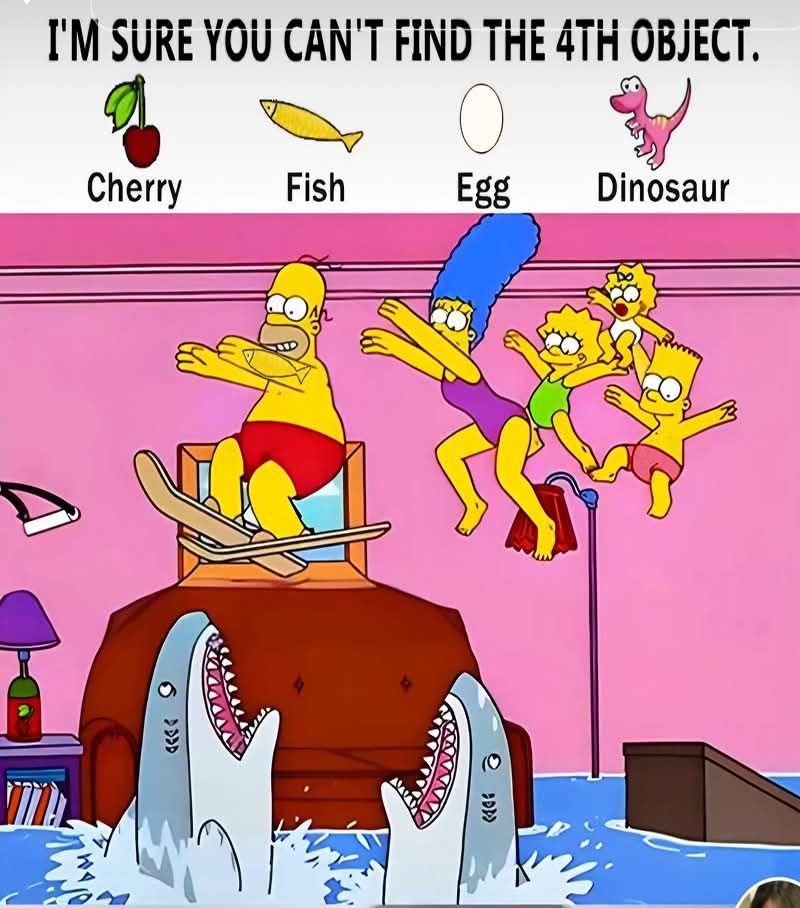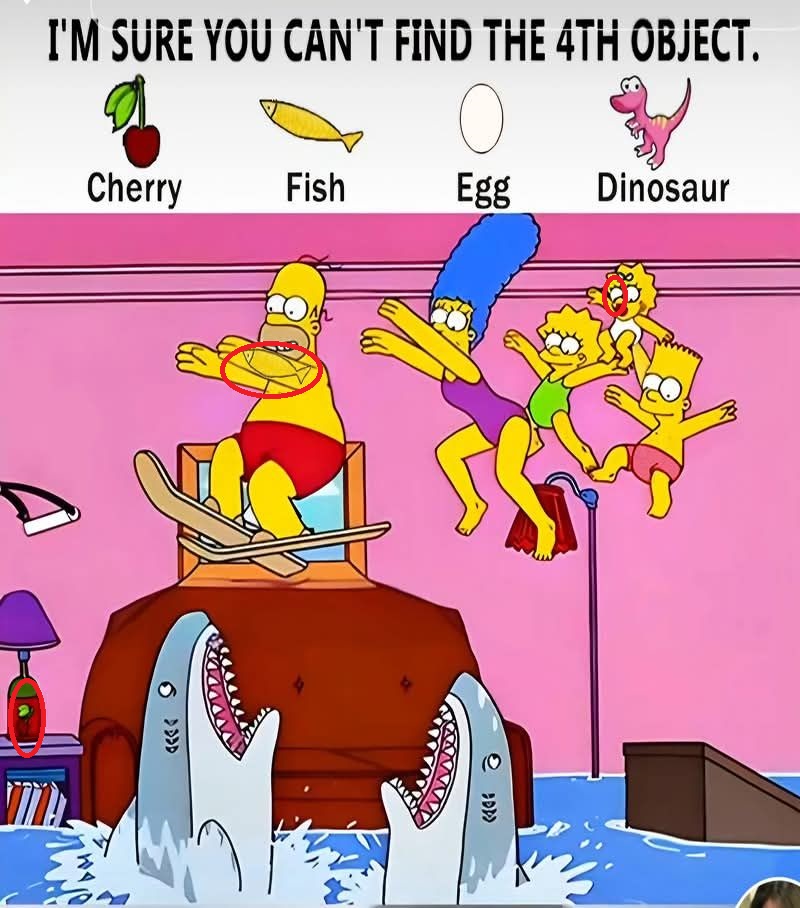Visual puzzles have a way of capturing our attention like nothing else. They challenge our perception, push our problem-solving skills to the limit, and, most importantly, ignite our curiosity. One of the most intriguing puzzles in recent times involves a chaotic yet hilarious image of the Simpson family. In this puzzle, we are tasked with finding four hidden objects: a cherry, a fish, an egg, and a dinosaur.
At first glance, the image seems nothing more than a comedic scene from the Simpsons’ chaotic living room. However, as you dive deeper, the real challenge emerges – locating the cleverly hidden objects. Let’s break down the puzzle and see how this seemingly simple task becomes a mind-bending challenge.

Why Are Visual Puzzles So Engaging?
Why do visual puzzles fascinate us so much? The answer lies in the way our brains process complex information. When faced with a chaotic image, our minds attempt to make sense of it by focusing on familiar patterns. Puzzles that challenge this instinct force us to think differently and change our perspective.
The Simpson family puzzle is the perfect example. The scene is not just visually overwhelming but also strategically designed to trick the eye. The objects we’re looking for are cleverly camouflaged within everyday elements, making them almost invisible at first glance.
Breaking Down the Puzzle: Why It’s So Tricky
The Simpson family image shows a lively and chaotic scene: the family members are jumping off the couch while two sharks emerge from the water flooding their living room. At first glance, the visual chaos distracts us, making it difficult to focus on the small hidden objects. The humorous and exaggerated elements of the scene make it easy to overlook the subtle details that matter.
The challenge becomes even more perplexing when we realize that one of the objects – the dinosaur – seems to be missing entirely. Is it really there, or are our eyes playing tricks on us? This puzzle requires more than just keen eyesight; it demands critical thinking and a shift in perspective.
Video: The Simpsons Jump the Shark
Guiding the Viewer: How to Spot the Hidden Objects
If you find yourself lost in the chaos, don’t worry – you’re not alone. Many people struggle to find the hidden objects because they are cleverly integrated into the visual noise. Here’s a strategic approach to help you locate each item:
- Start with the Most Obvious: Begin by scanning the larger, more prominent areas. Sometimes the objects are hiding in plain sight.
- Focus on Colors and Shapes: Look for the cherry, fish, egg, and dinosaur by focusing on their typical shapes and colors.
- Ignore the Distractions: The sharks and jumping figures can easily draw your attention away. Instead, focus on the still and less obvious parts of the image.
- Look for Unusual Details: The objects are often blended into areas where you wouldn’t expect them. Don’t just look at the characters; scan the furniture, accessories, and background.
- Rethink What You See: Sometimes, what you think is part of a character might actually be one of the hidden objects.
Revealing the Hidden Objects: The Solution
After carefully analyzing the image and shifting our perspective, here’s where the objects are hidden:
- Cherry: The cherry is cleverly placed on the green bottle on the small table to the left. It’s not an actual fruit but part of the decorative label on the bottle. The round, red shape easily blends in with the chaotic scene.
- Fish: The fish is ingeniously disguised as part of Homer’s arm. His skin tone and the curve of his arm resemble the shape of a small fish, making it almost indistinguishable at first.
- Egg: The egg is hidden in plain sight as the eye of Maggie (the one in the white swimsuit). The round, white shape of her eye looks just like an egg.
- Dinosaur: Here’s the biggest twist: the dinosaur doesn’t exist in the image at all! The puzzle intentionally misleads us by including an object that we can’t find. This clever trick plays on our natural tendency to trust the given instructions.

The Deceptive Dinosaur: Why Do We Fall for It?
The absence of the dinosaur teaches us a valuable lesson about assumptions. Our brains often follow instructions without questioning their validity. In this case, the puzzle’s prompt convinced us that all four objects existed. As a result, we tirelessly searched for something that wasn’t even there.
This phenomenon highlights how easily we can be led to believe in something simply because we’re told it exists. The real challenge wasn’t just finding the objects but questioning the premise itself.
The Takeaway: Why Puzzles Teach Us to Think Differently
This visual puzzle, like many others, serves as a reminder that not everything we’re told is necessarily true. Sometimes, the most challenging part is not the search itself but questioning whether what we are looking for actually exists.
In life, we often pursue goals or follow instructions without critically evaluating their validity. This puzzle nudges us to think differently, to challenge assumptions, and to approach problems with a fresh perspective. Whether it’s finding hidden objects or tackling everyday challenges, sometimes the answer lies in rethinking the problem itself.
Video: Find It out Hidden Objects part-6#quiztime #shortsfeeds #shorts #jobailislam #foryou
Conclusion: The Joy of Uncovering the Truth
The Simpson family visual puzzle is more than just an entertaining challenge – it’s a test of our perception and critical thinking skills. By carefully observing and questioning what we see, we can uncover the truth hidden in plain sight. The biggest surprise comes from realizing that not all instructions are accurate, reminding us to always think critically.
Visual puzzles like this one not only amuse us but also teach us valuable lessons about perspective and problem-solving. Next time you encounter a puzzling image, remember to question your assumptions, change your viewpoint, and never give up – because sometimes, the real trick is in how we choose to see the world.
If you’ve enjoyed this breakdown, why not challenge your friends and see if they can find the hidden objects? Share the puzzle and put their observation skills to the test!